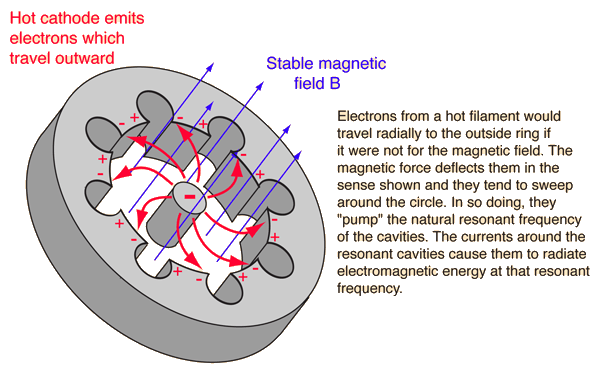An interesting experiment, I am not equipped to try.....
Here is an Idea I have been mulling over for a few days, and would really like to try, however I only have so much time on my plate...Perhaps someone will take it a bit further.
For lack of a better name, I will call this the Hydroelectric Magnetron.
This is a very simple idea and mechanism, but first one needs to understand the operation of the magnetron, in its simplest form.

Here you can see the magnetic field direction in blue. Perpendicular to this is the electric field shown in red. The electric field gradient lies from a center point outwards, much like our own earth, an electron or an atom (radial potential gradient).
Because of the right hand rule...when we have movement of electrons through the perpendicular magnetic field, we create rotation. This is as far into magnetron theory as we will go.
I envision the hydroelectric magnetron as follows.
Imagine a water vortex, rotation in this case is induced simply by gravity, much like a bathtub, toilet or those neat little soda pop bottle experiments.
A magnetic field (via permanent magnets) is placed perpendicular to this rotation, exactly in the same orientation as the magnetron.
Now imagine the soda pop bottle, wrapped in foil on the outside. This constitutes one plate of a capacitor. Now the second plate of the capacitor will be a metallic cone fiting the void created by the vortex. Basically what we have is a capacitor with a rotating water dielectric. There is a soda bottle wall in between the capacitive plates as well so as not to allow conduction.
I would also mention that I would disolve an ionic compound such as table salt in the water to get a good distribution of positive and negative ions.
It is known that current can constitute the movement of electrons relative to a static background, or....in the case of conduction through a fluid such as described here, current can constitute the movement of charged ions.
Now....
The radial electric capacitor will cause an alignment of ions water molecules within the vortex in the radial direction. The perpendicular magnetic field would want to cause rotation, however because there is no current flow, it will not.
However gravity (or a small motor) will cause rotation for us (vortex)
Question is.....what will happen???? We are causing an artificially induced rotation, of organized ions, creating a current. This current will interact with the perpendicular magnetic field. The movement of this interaction will be rotational as well.......
WHAT WILL HAPPEN!?!?!?!?!?!?!?!?!?!
Here is an Idea I have been mulling over for a few days, and would really like to try, however I only have so much time on my plate...Perhaps someone will take it a bit further.
For lack of a better name, I will call this the Hydroelectric Magnetron.
This is a very simple idea and mechanism, but first one needs to understand the operation of the magnetron, in its simplest form.

Here you can see the magnetic field direction in blue. Perpendicular to this is the electric field shown in red. The electric field gradient lies from a center point outwards, much like our own earth, an electron or an atom (radial potential gradient).
Because of the right hand rule...when we have movement of electrons through the perpendicular magnetic field, we create rotation. This is as far into magnetron theory as we will go.
I envision the hydroelectric magnetron as follows.
Imagine a water vortex, rotation in this case is induced simply by gravity, much like a bathtub, toilet or those neat little soda pop bottle experiments.
A magnetic field (via permanent magnets) is placed perpendicular to this rotation, exactly in the same orientation as the magnetron.
Now imagine the soda pop bottle, wrapped in foil on the outside. This constitutes one plate of a capacitor. Now the second plate of the capacitor will be a metallic cone fiting the void created by the vortex. Basically what we have is a capacitor with a rotating water dielectric. There is a soda bottle wall in between the capacitive plates as well so as not to allow conduction.
I would also mention that I would disolve an ionic compound such as table salt in the water to get a good distribution of positive and negative ions.
It is known that current can constitute the movement of electrons relative to a static background, or....in the case of conduction through a fluid such as described here, current can constitute the movement of charged ions.
Now....
The radial electric capacitor will cause an alignment of ions water molecules within the vortex in the radial direction. The perpendicular magnetic field would want to cause rotation, however because there is no current flow, it will not.
However gravity (or a small motor) will cause rotation for us (vortex)
Question is.....what will happen???? We are causing an artificially induced rotation, of organized ions, creating a current. This current will interact with the perpendicular magnetic field. The movement of this interaction will be rotational as well.......
WHAT WILL HAPPEN!?!?!?!?!?!?!?!?!?!






Comment